Big Red
Ken Neill
Published in the Chesapeake Angler
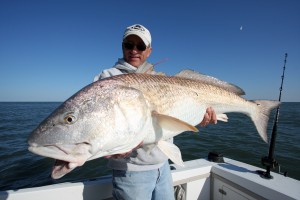 Each year, we anxiously await the arrival of Big Red. For us, this means that spring has sprung and the doldrums of winter are finally over. While anchored on a wreck, waiting for a tautog bite, my fishing buddies will spend the time discussing when they think we will catch our first big red drum of the year. We talk about the past year and hope that they will show earlier this year. There is a lot of anticipation about catching a fish that we are just going to let go after we catch it. There is just something special about a big red drum.
Each year, we anxiously await the arrival of Big Red. For us, this means that spring has sprung and the doldrums of winter are finally over. While anchored on a wreck, waiting for a tautog bite, my fishing buddies will spend the time discussing when they think we will catch our first big red drum of the year. We talk about the past year and hope that they will show earlier this year. There is a lot of anticipation about catching a fish that we are just going to let go after we catch it. There is just something special about a big red drum.
 Big reds will show on Virginia’s Eastern Shore sometime in April. These early fish will be actively feeding right in the surf. About this same time, there will be good runs going on in the surf of the Outer Banks. When the reports start coming in from Hatteras, you can head down there or head to the beaches of the Eastern Shore. You can expect to see a dedicated group of red drum anglers from the beaches of the Eastern Shore during the full moon of April. They mark this time on their calendar each year. These purists call their fish “channel bass” and feel that to truly appreciate these fish, you need to catch them from the shore.
Big reds will show on Virginia’s Eastern Shore sometime in April. These early fish will be actively feeding right in the surf. About this same time, there will be good runs going on in the surf of the Outer Banks. When the reports start coming in from Hatteras, you can head down there or head to the beaches of the Eastern Shore. You can expect to see a dedicated group of red drum anglers from the beaches of the Eastern Shore during the full moon of April. They mark this time on their calendar each year. These purists call their fish “channel bass” and feel that to truly appreciate these fish, you need to catch them from the shore.
We will be on the other side of the breakers fishing out of a boat. In between the guys fishing from shore and those in the boats will be a group of very experienced kayak anglers. You will see them in their colorful pieces of plastic fishing right along the bars where the waves are breaking. Most of this action will occur in the inlet between Fisherman’s and Smith Islands. I think that they are nuts but there are times that the kayaks can get to where the rest of us cannot and that will sometimes result in the best catches.
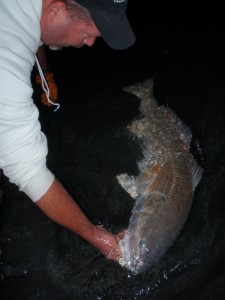 As we move into May, the surf fishery continues but more fish become available out away from the beach. Schools of big red drum will cruise around and feed on the shoals at the mouth of the Chesapeake Bay. Nautilus, 9-Foot (Inner Middle Ground), and Latimer Shoals become red drum hot spots. There is a hill on the ocean side of the high-rise area of the Chesapeake Bay Bridge Tunnel. You can find it between buoys 8, 10 and Fisherman’s Island. It can be a very good drum spot particularly later in the shoal fishery season. We need to give it a name. Some just refer to it as part of the nearby Nautilus Shoal but it really is a separate area. This shoal fishery will be prime from mid-May through the month of June.
As we move into May, the surf fishery continues but more fish become available out away from the beach. Schools of big red drum will cruise around and feed on the shoals at the mouth of the Chesapeake Bay. Nautilus, 9-Foot (Inner Middle Ground), and Latimer Shoals become red drum hot spots. There is a hill on the ocean side of the high-rise area of the Chesapeake Bay Bridge Tunnel. You can find it between buoys 8, 10 and Fisherman’s Island. It can be a very good drum spot particularly later in the shoal fishery season. We need to give it a name. Some just refer to it as part of the nearby Nautilus Shoal but it really is a separate area. This shoal fishery will be prime from mid-May through the month of June.
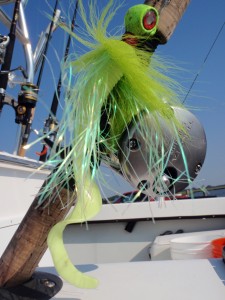 During July, things change. These fish will form large aggregations, presumably for spawning. Some of these fish will move offshore while other groups will be found around the lower bay and out along the ocean front. They will still feed during this time though it is more of an incidental sight fishery. With the rebound of the red drum population and all of the boats cruising around looking for cobia, these chance encounters have become more common. When you see a school, cast them a jig and hang on. As long as you can keep track of them, the fishing is fantastic.
During July, things change. These fish will form large aggregations, presumably for spawning. Some of these fish will move offshore while other groups will be found around the lower bay and out along the ocean front. They will still feed during this time though it is more of an incidental sight fishery. With the rebound of the red drum population and all of the boats cruising around looking for cobia, these chance encounters have become more common. When you see a school, cast them a jig and hang on. As long as you can keep track of them, the fishing is fantastic.
Late August into September, these fish will return to their inshore feeding behavior. Typically, a fishery will develop around the islands of the Chesapeake Bay Bridge Tunnel. As the fall progresses, you can pretty much track these fish down the coast. There will be a run at Sandbridge sometime in October into November. By December, the fish will be around Cape Lookout and we will be wondering how soon in April that they will return again.
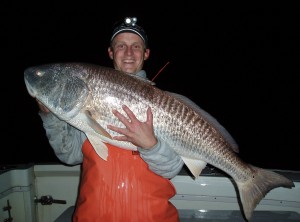 Catching these fish is not that difficult. It is more a matter of being where they are when they are feeding. The occasional big red will surprise anglers drifting for flounder or those anchored up and chumming for cobia. The most common way to target these fish is to use a fish finder rig and fish baits on the bottom. Red drum will eat a variety of baits. Live or cut fish works well. Peeler crab is probably the best bait and it is the bait I always used to use for springtime red drum. Pop the top shell off leaving the soft shell exposed, cut the crab in half, thread the crab on a hook, rubber band the legs to the hook shank and you are ready to go. The problem with using peeler crab and fish baits is all of the other stuff out there that like to eat it also. You can spend all of your time catching a variety of skates, sharks, and rays.
Catching these fish is not that difficult. It is more a matter of being where they are when they are feeding. The occasional big red will surprise anglers drifting for flounder or those anchored up and chumming for cobia. The most common way to target these fish is to use a fish finder rig and fish baits on the bottom. Red drum will eat a variety of baits. Live or cut fish works well. Peeler crab is probably the best bait and it is the bait I always used to use for springtime red drum. Pop the top shell off leaving the soft shell exposed, cut the crab in half, thread the crab on a hook, rubber band the legs to the hook shank and you are ready to go. The problem with using peeler crab and fish baits is all of the other stuff out there that like to eat it also. You can spend all of your time catching a variety of skates, sharks, and rays.
 Today, we mostly use live, adult, hard crabs for bait. We will break the claws off and cut the tips of the spines off to make the crab more defenseless. Run a hook in through the bottom shell and out the top shell at the rear of the crab or out near the spine. This almost eliminates all of the unwanted bites. Now when we hook up, it is almost always a big red drum. If I have some peeler crabs, we now mostly fish them the same way, alive with the hard shell in place.
Today, we mostly use live, adult, hard crabs for bait. We will break the claws off and cut the tips of the spines off to make the crab more defenseless. Run a hook in through the bottom shell and out the top shell at the rear of the crab or out near the spine. This almost eliminates all of the unwanted bites. Now when we hook up, it is almost always a big red drum. If I have some peeler crabs, we now mostly fish them the same way, alive with the hard shell in place.
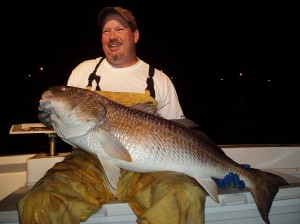 Red drum will feed day and night. They will be most active up on the shoals and in the surf during the nighttime. Many feel the bite is best during the times of the full moon and you can expect to find fleets of boats over the shoals during the nights of the full moons of May and June. We will be out there any night that we can. We will usually set up in the afternoon and fish as long as we have the time. When we can, we will fish all through the night and through the first couple of hours of daylight when we will pick up and do something else.
Red drum will feed day and night. They will be most active up on the shoals and in the surf during the nighttime. Many feel the bite is best during the times of the full moon and you can expect to find fleets of boats over the shoals during the nights of the full moons of May and June. We will be out there any night that we can. We will usually set up in the afternoon and fish as long as we have the time. When we can, we will fish all through the night and through the first couple of hours of daylight when we will pick up and do something else.
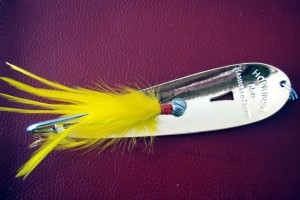 In addition to fishing baits on the shoals and in the surf, these fish can be caught on the troll. They will readily hit a spoon trolled in front of them. We will pull a spread of 550 Hammered Hopkins or other similar spoons. Place an inline trolling sinker of 6-8 ounces about 20 feet in front of the spoon and slowly troll over and around the shoals and along the beaches of Fisherman’s and Smith Islands. A screaming drag will let you know when a fish has found your spoon. This is a daytime method to catch springtime reds. With some spoons and enough crabs, you will not need to come back to the dock at all.
In addition to fishing baits on the shoals and in the surf, these fish can be caught on the troll. They will readily hit a spoon trolled in front of them. We will pull a spread of 550 Hammered Hopkins or other similar spoons. Place an inline trolling sinker of 6-8 ounces about 20 feet in front of the spoon and slowly troll over and around the shoals and along the beaches of Fisherman’s and Smith Islands. A screaming drag will let you know when a fish has found your spoon. This is a daytime method to catch springtime reds. With some spoons and enough crabs, you will not need to come back to the dock at all.
